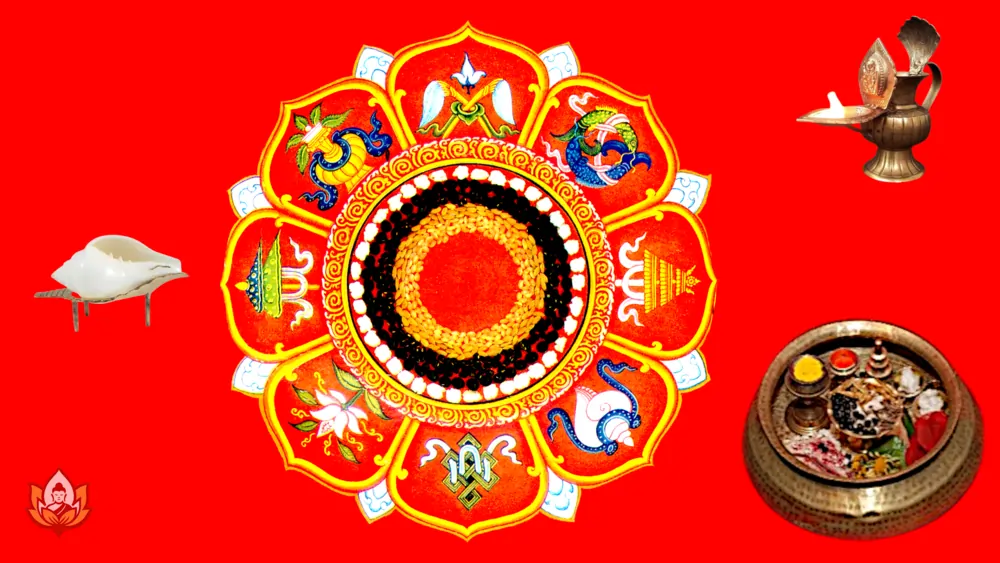Introduction: Worshipping the Self in Mha Puja
Mha Puja, in Newari म्ह: पुजा, in Sanskrit देह पुजा, a sacred ritual practiced by the Newar community in Nepal, derives its name from the Newari word Mha (म्ह:), which translates to “body”. However, in the context of Mha Puja, Mha refers to the entire self – body, mind, and speech. This ritual focuses on the purification and worship of the self, recognizing the interconnectedness of physical, mental, and spiritual well-being. Performed annually, Mha Puja serves as a symbolic reminder of self-care, self-respect, and the spiritual path one must follow.
In Bajracharya culture, which follows the teachings of Vajrayana Buddhism, Mha Puja holds a significant role. The ultimate goal of this path is enlightenment, a state of ultimate understanding and spiritual liberation. In this journey toward enlightenment, the body is seen as a sacred vessel that must be honored and cared for. Mha Puja reflects this belief, as participants symbolically cleanse and worship their body, mind, and speech. By focusing on the self, the ritual emphasizes that enlightenment begins with self-awareness and purification.
Mha Puja has been passed down through generations for thousands of years within Bajracharya and Newar culture. Though the exact origin is undocumented, the practice is believed to be ancient, symbolizing self-purification and the worship of the body, mind, and soul. Some sources speculate that Mahasiddhi Lila Bajra Bajracharya, one of the four most popular Bajracharya priests, might have initiated this tradition. However, there is no concrete evidence to confirm this belief.
Traditionally, the ritual is performed by families, with each member sitting in a meditative pose. They align themselves in a row according to age, with the eldest at the top and the youngest at the bottom. This group setting underscores the communal aspect of the ritual, while the meditative posture encourages mindfulness and introspection. In this article, we will guide you through the entire process step by step.
A New Year, A New You: The Significance of Mha Puja in Swonti Festival
Mha Puja is celebrated on Kartik Sukla Pratipada, the day after Laxmi Puja (Aaushi), according to the lunar calendar. It is one of the most important days of the Newari Swonti festival, which is also known as Tihar festival celebrated throughout Nepal. The word Swonti comes from Newari word “Swonu Tithi“, meaning “three-day festival”, each day dedicated to different forms of worship. The first day is Laxmi Puja, honoring the goddess of wealth, Laxmi. The second day is Mha Puja, dedicated to the worship of the self. The third day is Kija Puja, where sisters honor their brothers.
This sacred timing also coincides with the Newari New Year, known as Nepal Sambat, adding extra significance to the ritual. Worshipping the self at the start of the new year allows participants to mentally and spiritually prepare for the challenges and opportunities of the coming year. The act of purifying the mind and body through Mha Puja serves as a symbolic cleansing, helping individuals begin the year with renewed energy and focus. It’s a spiritual fresh start, reinforcing the connection between one’s inner self and the universe, and setting the stage for personal growth and harmony in the year ahead.
Essential Items for the Mha Puja: What You Need
Before performing the Mha Puja, certain utensils and offerings are required to ensure a smooth and meaningful ritual. Here is a breakdown of the items you’ll need:
Traditional Puja Utensils
- Puja Plate (पुजभ) – A plate to hold various offerings.
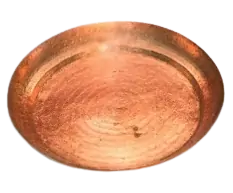
- Sina: Mu (सिन्ह:मू) – A container specifically for holding Sina or Tika
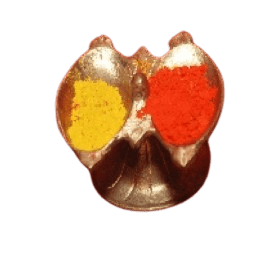
- Conch Shell (संख) – A sacred conch used during the ritual for offering water.
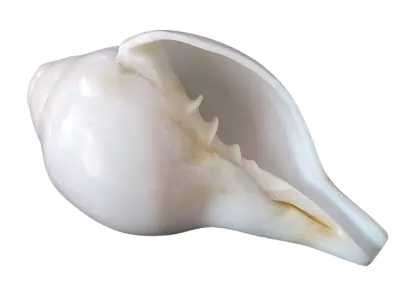
- Conch Shell Stand (मस) – A stand to hold the conch securely.

- Bowl for Samay Baji: Lapicha (लंपिचा) – A bowl to hold the Samay Baji (a traditional Newar food offering). Traditional bowl is called Lapicha (लंपिचा).
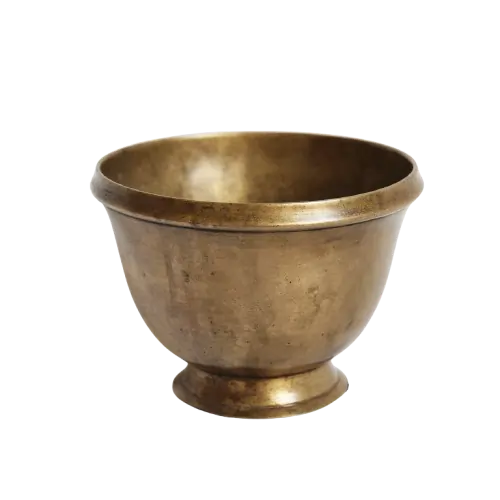
- Sukunda (सुकुन्दा) – A traditional oil lamp used in the puja.
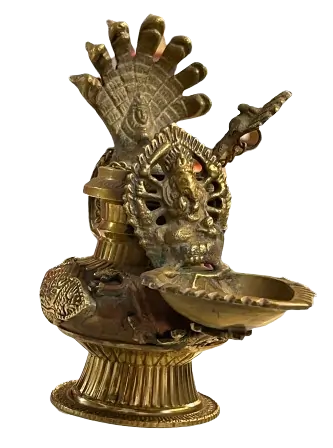
- Dhalacha (धालाचा) for Rice Wine (थ्वँ) – A container for offering rice wine.
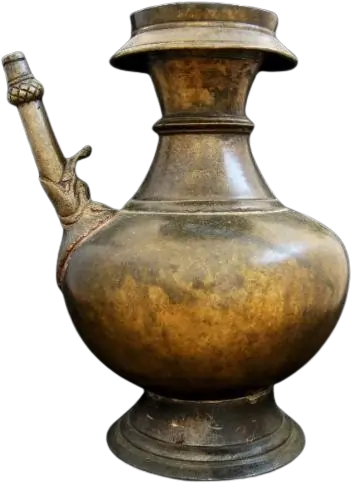
- Small Brass Pitcher for Cow Milk – A small brass pitcher or any bowl to hold cow milk offering.

- Baukucha (बौकुंचा) for Oil Stamp – A small brass utensil to stamp Mandala center with Oil stamp. If you don’t have Baukuncha, you can use bottom of Khola (ख्वला) for oil stamping.
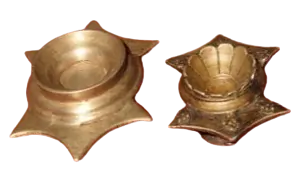
- Bata (बाता) for Egg Sagan – A bowl or contain to hold Egg Sagan
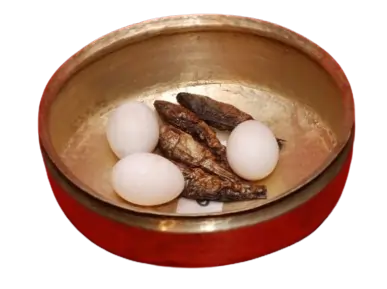
- Anti (अन्ति) for Alcohol serving – A traditional brass pitcher to serve alcohol.
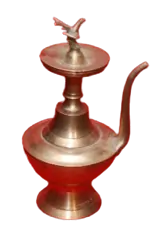
- Khola (ख्वला) for Alcohol serving – A traditional brass container to serve alcohol during Sagan.
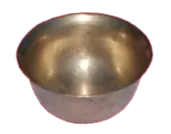
Offerings for the Puja
- Rice (Ashyata, अक्षता) – Symbolic grains of rice used in offerings.
- Incense (धुप) – For purifying the environment and invoking the deities.
- Yellow Sina (Tika) – A yellow powder used during the puja. Yellow sina is applied with the middle finger.
- Red Sina (Tika) – A red powder used in the ritual. Red sina is applied with the ring finger.
- Taya (ताये) – Taya refers to popped paddy rice, which are often offered to deities.
- Cotton String (Ita, इता) – Sacred threads used for burning fire/light.
- Jajanka (जजंका) – Jajanka refers to sacred cloth or fabric used in the ritual.
- Flowers – For offering to deities and symbolizing purity.
- Naivedya (Samay Baji) – A food offering that includes traditional Newar snacks.
- Cow Milk – A pure offering for the deities.
- Rice Wine (थ्वँ) – Offered as a drink for the gods.
- Alcohol (अय्ला) – Offered as a drink during Sagan.
- Fruits and Sweets – Additional food offerings symbolizing abundance and prosperity.
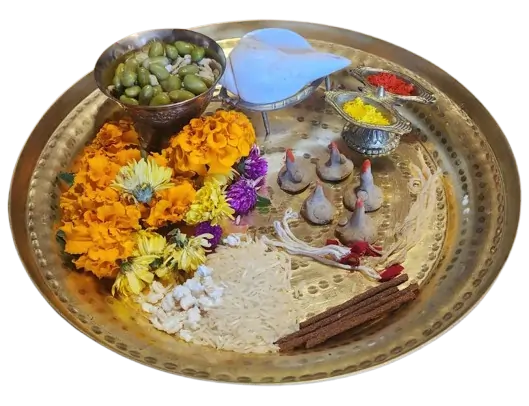
Mandala Decoration
- Taya (ताये) – Taya refers to popped paddy rice, which are often offered to deities. Taya, popped paddy rice is slightly different from puffed rice.
- Aakhe (आखें) – Unbroken brown rice grains
- Paddy Rice (वा) – Unprocessed rice grains with hull
- Black Soybean (हाकु मुस्या) – Dried black soybean
- Black Whole Lentil (हाकु माय्) – Dried black whole lentils
- Oil Stamp (चिकं मण्ड:) – Small circular oil stamp at center of Mandala
Tashi and Fruits
- Tashi (तः सि) – Bimiro (बिमिरो) in Nepali, Citron fruit in English, Jambhala (जम्भल) in Sanskrit. Its hard to find Tashi outside Nepal and Asia. If you can not find Tashi, then subsitute with big yellow lemon.
- Pomelo (भोगटे)
- Whole walnut (खोसिं)
- Guava (आमासी)
- Asian pear (पासी)
- Banana (केरा)
- Any other seasonal fruits.
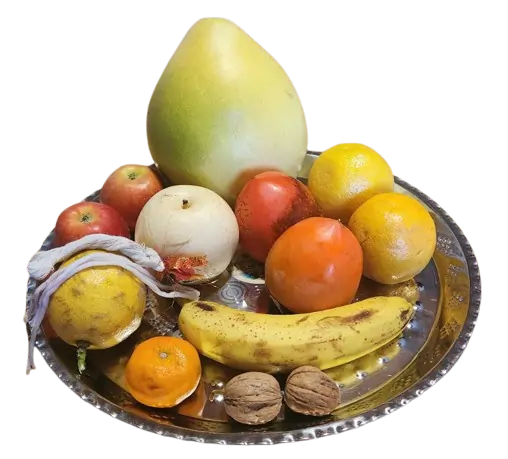
Offerings on top of Tashi (तः सि)
- Khelu Ita (खेलु इता) – Big thick cotton string soaked in oil for fire/light.
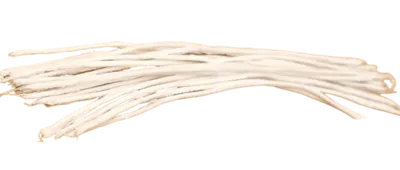
- Big Jaganka – Big thick Jaganka to be worn by individual performing Mha Puja
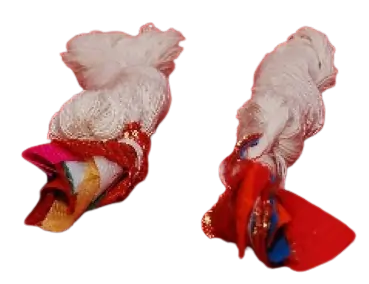
- Flower Garland – Flower garland typically made of Gway Swa / Supari Phul / Globe Amaranth flower. Some Bajracharya families don’t use flower garland. So, this is optional item.

Items for Egg Sagan
- Boiled Duck Egg: Traditionally, Bajracharyas use only duck eggs for rituals.
- Dried Fish: Dried fish fried in oil.
- Red Rice Sina/Tika (ह्याँगु जाकि सि न:): A mix of rice, red abir (sindoor), and yogurt.
- Dhau (Yogurt / Curd): Plain yogurt for ritual offering.
- Aila (अय्ला): Alcohol, traditionally homemade, symbolizing purity.
- Whole Dried Betel Nut (Gway): Considered a symbol of good luck.
- Flowers: Offered as part of the ritual for auspiciousness.
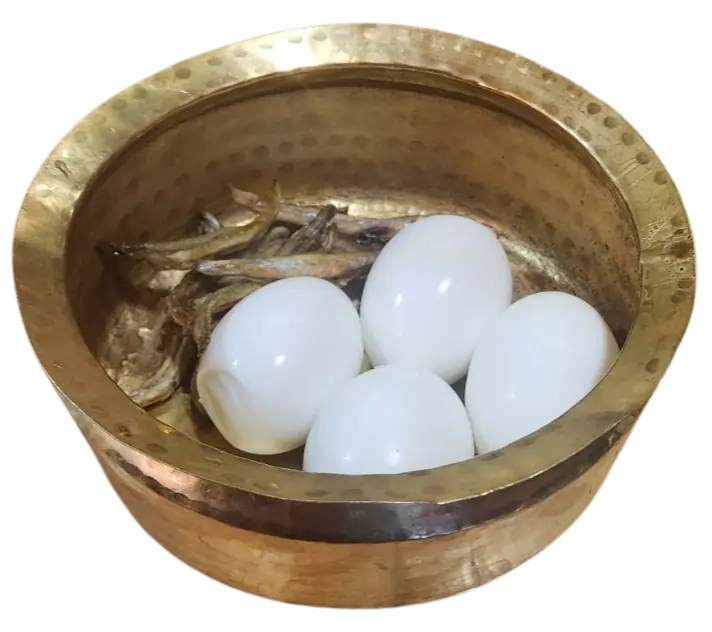
Miscellaneous
- Potash powder (stone powder) for Drawing the Mandala (पोताय्) – Potash is used to create the sacred mandala, a key element of the ritual.
- Goja (गोजा) – Rice cone. Made with Goja powder or wet puffed rice. Five Gojas are required per person for Mha Puja.
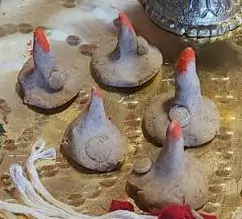
- Oil – Oil for oil stamping in middle of Mandala
- Pure Water – Offer water to Mandala
These items are essential to properly conduct the Mha Puja, each with its own symbolic meaning and purpose in honoring the deities and guiding the practitioner toward spiritual fulfillment.
Preparing for the Ritual: Setting the Sacred Space
Before the Mha Puja can begin, the sacred space must be carefully prepared. This involves setting up a ritual area for each family member, with attention to detail and symbolism. The preparations create an atmosphere that fosters mindfulness, focus, and respect for the self. Here’s how the space is prepared:
1. Sitting in Meditative Pose
Each member of the household begins by sitting in a meditative pose (sit in cross-legged pose), aligning themselves in a row from eldest to youngest. This posture encourages a calm, introspective state, setting the tone for the ritual.

2. Drawing the Mandala
The next step is to create a mandala, a symbolic representation of the self, using potash powder. Each person draws their own mandala, which serves as a spiritual focal point during the ritual. The mandala represents the individual’s body, speech, and mind, and forms the base for the rest of the offerings.
Start by using white potash powder (stone powder) to draw a circle representing the Mandala. Above the main circle, there are three smaller circles, with the center one featuring a tail-like extension, which is represented by Top Goja (च्वये च्वंगु ग्वःजा, rice cone). This Top Goja represents the Dikpalas (8 directional deities) and protectors of all directions.
The traditional Mha Puja mandala features intricate Astamangala symbols on its outer edges. However, the most common and simple design that serves as the foundation for the Mha Puja ritual is described below, embodying deep meaning despite its simplicity. Checkout video guide by Guruju Prajjwal Bajracharya to build the mandala.
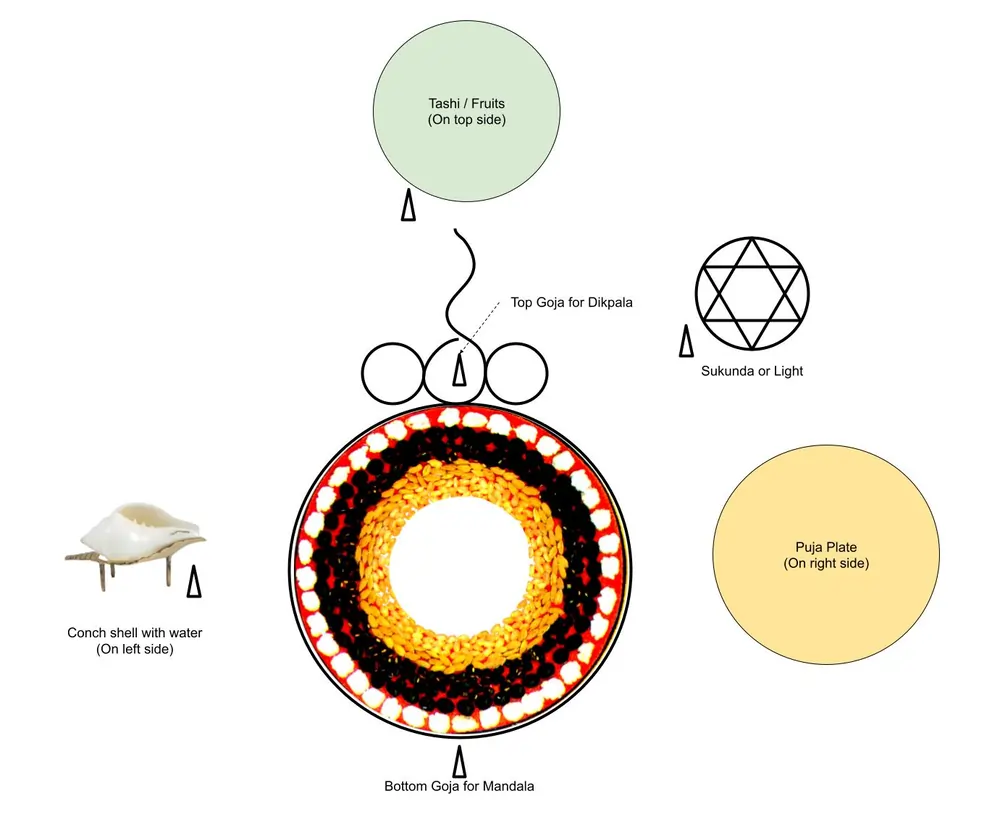
3. Layering the Mandala
The mandala is then layered with various symbolic materials. Each layer holds significance:
- First layer: Taya – ताये (popped paddy rice) forms the outermost circle, symbolizing abundance and prosperity.
- Second layer: हाकु मुस्या – Dried black soybeans represents stability and strength.
- Third layer: हाकु माय् – Dried whole black lentils adds protection and grounding.
- Fourth layer: वा – Paddy rice symbolizes life and sustenance.
- Fifth layer: आखें – Aakhe (unbroken brown rice grains) forms the innermost layer and represents purity and wholeness.
- Center: A small hole is left in the center of the mandala for the oil stamp – चिकं मण्डः, which will be added during the main ritual.
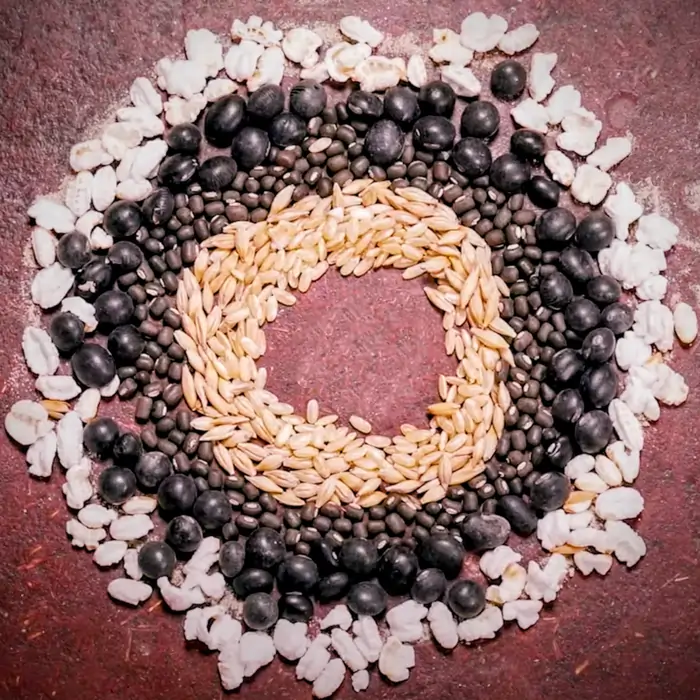
3.1. Modern Mandala: Simplifying Mha Puja with Stencils
For those who find traditional Mha Puja Mandala (Mandap) creation challenging, modern stencils offer a convenient solution. Stencils, especially those made from brass or paper, make it easy to create a clean, symmetrical mandala. The brass stencil featuring the Astamangal symbols is particularly popular, as it quickly and accurately outlines the essential designs. Using these tools maintains the ritual’s integrity while easing the process, ensuring that more people can participate in Mha Puja without struggling to draw by hand.
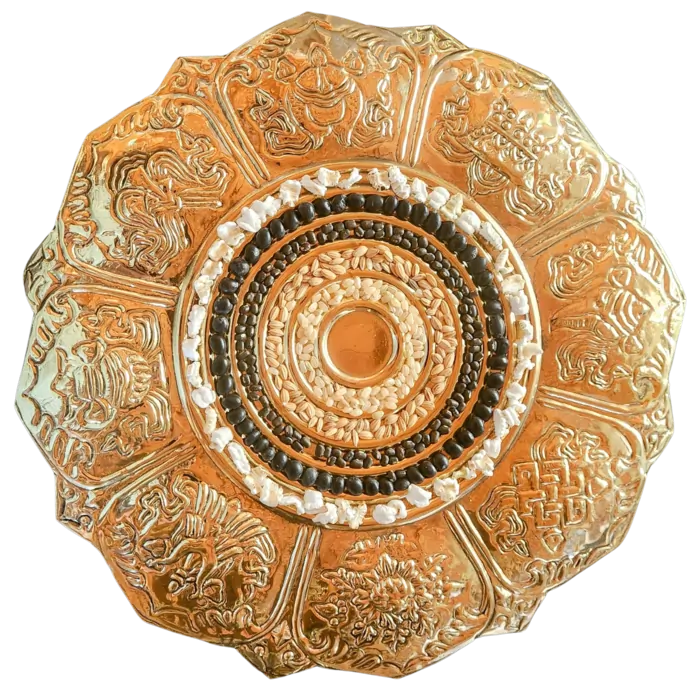
4. Arranging the Offerings
Once the mandala is complete, several important items are placed around it:
- Sukunda (Oil Lamp): Positioned at the top right corner of the mandala, the oil lamp symbolizes wisdom and light. One Goja (ritual offering) is placed beside the Sukunda to honor it.
- Puja Plate: The puja plate, containing various ritual items, is placed on the right side of the mandala.
- Conch Shell with Water: On the left side, a conch shell filled with water is placed to represent purity. Another Goja is placed beside the conch shell for worship.
- Goja for Mandala: A Goja is placed at the bottom of the mandala, which is used to hold incense. This represents the mandala itself.
- Goja for Dikpalas: A final Goja is placed at the top of the mandala, representing the Dikpalas, or eight directional deities who protect all directions.
5. Placing the Tashi (तः सि) / Fruit Tray Offerings
At the top of the mandala, a tray of Tashi (तः सि) and fruits, is placed with one Goja. Tashi is known as Bimiro (बिमिरो) in Nepali, Citron fruit in English, and Jambhala (जम्भल) in Sanskrit. Its hard to find Tashi outside Nepal and Asia. If you can not find Tashi, then subsitute with big yellow lemon.
On top of Tashi (तः सि) includes:
- Khelu Ita (a thick cotton string soaked in oil)
- Thick Jajanka (a traditional sacred thread)
- A flower garland, often made of Gway Swa (Globe Amaranth flower). Some Bajracharya families don’t use flower garland. This is optional.
Other fruits are also placed on the tray, including:
- Pomelo (भोगटे)
- Whole walnut (खोसिं)
- Guava (आमासी)
- Asian pear (पासी)
- Banana (केरा)
- Any other seasonal fruits.
These offerings symbolize prosperity, longevity, and the blessings of nature. The tray is an integral part of the ritual, representing abundance and the nourishment of both the body and mind.
By following these detailed steps, the sacred space for Mha Puja is prepared, ensuring that the ritual can be performed in a peaceful, focused, and spiritually uplifting environment.
Step-by-Step Guide to Mha Puja
1. Cleansing the Body, Mind, and Speech
Before beginning the Mha Puja, practitioners must purify their body (काय), mind (चित्त), and speech (वाक). This initial step clears distractions and negative energy, creating a sacred space within for the ritual. Cleansing aligns the individual with the spiritual purpose of Mha Puja and prepares them for deeper introspection.
1.1. Sprinkle water: नसला कायेगु
To begin, take water from the conch shell in the right hand and sprinkle it into the mouth three times while chanting the following mantra:
ॐ ह्रिं स्वाहा । ॐ ह्रिं स्वाहा । ॐ ह्रिं स्वाहा ॥
Om Hrim Swaha । Om Hrim Swaha । Om Hrim Swaha
1.2. Purify body, speech and mind
Chant the following Sanskrit mantras to purify the body, speech, and mind:
काय विशोधने स्वाहा ।
Kaya Vishodhane Swaha
वाक विशोधने स्वाहा ।
Vak Vishodhane Swaha
चित्त विशोधने स्वाहा ।
Chitta Vishodhane Swaha
Meaning of the Sanskrit Mantras:
- Kaya Vishodhane Swaha
“I purify my body.” - Vak Vishodhane Swaha
“I purify my speech.” - Chitta Vishodhane Swaha
“I purify my mind.”
These mantras help cleanse the practitioner at a deeper level, ensuring that their body, words, and thoughts are purified before proceeding with the sacred puja.
2. Applying the चिकं मण्डः – Chika Manda (Oil Stamp)
The eldest woman of the household applies the Chika Manda – चिकं मण्डः or oil stamp to the center of the Mha Puja Mandala. Chika Manda – चिकं मण्डः is a circular oil mark on the center of Mandala. This symbolizes the initiation of the ritual and represents the first step toward honoring the self.
The oil stamp (चिकं मण्डः) holds special meaning in the mandala as it is thought to last longer than other commonly used materials, due to oil’s slow evaporation rate. This quality enhances the symbolic value of placing an oil stamp at the center of the mandala, representing lasting blessings and stability throughout the ritual.
चिकं मण्डः (Chika Manda) is traditionally applied using Baukucha (बौकुंचा) by dipping it in oil and stamping a circular mark at the center of the Mandala. If Baukucha isn’t available, you can use the bottom circular part of a Khola (ख्वला) or simply create the circular oil stamp by hand at the center of the Mandala.
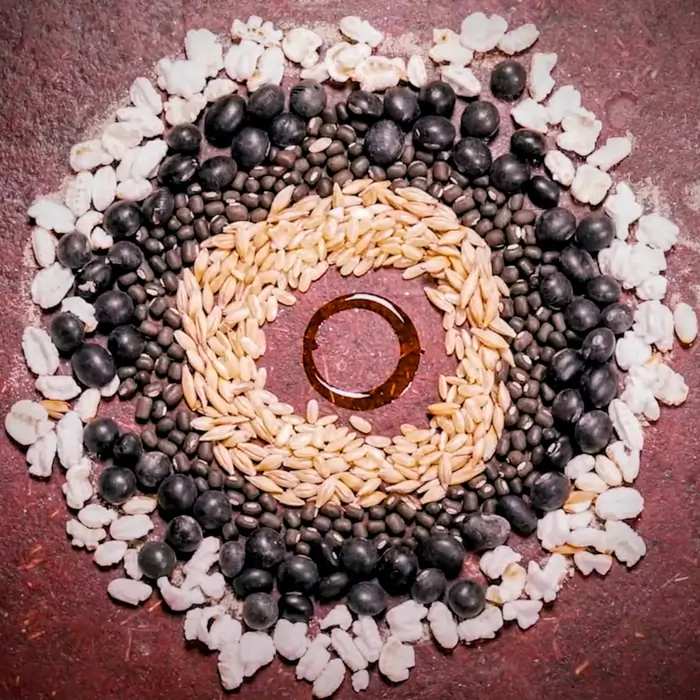
3. Performing the Main Mha Puja Ritual
The core of the Mha Puja ritual is the worship of the mandala, which symbolizes the practitioner’s body, speech, and mind. Traditionally, the main ritual is conducted through the Gurumandala Puja, a sacred and elaborate practice central to Bajracharya culture. However, newer generations are adopting an alternative approach to perform Mha Puja, preserving the tradition while simplifying it.
3.1. Gurumandala Puja: The Traditional Approach
In the Gurumandala Puja, the mandala serves as the focal point, representing the cosmic body and the self. The ritual involves precise steps and the recitation of numerous Sanskrit mantras, often lasting over an hour. Only highly trained practitioners, like Bajracharya priests, are equipped to lead this intricate ceremony. This ritual is believed to cleanse the self and bring the individual closer to enlightenment by purifying their body, speech, and mind. Read step-by-step guide to perform Gurumandala Puja.
Key aspects of the Gurumandala Puja:
- Mandala Worship: The mandala is honored as the embodiment of the practitioner’s inner universe. It forms the ritual’s foundation.
- Mantra Chanting: Numerous mantras are recited to invoke deities and cosmic forces. These mantras are critical to creating a sacred atmosphere.
- Complexity: Due to its detail-oriented nature, the Gurumandala Puja requires in-depth knowledge of Bajracharya rituals, making it challenging for those unfamiliar with it. Gurumandala ritual can take more than an hour to complete.
Important Note:
- If you are performing traditional Gurumandala Puja, complete it first, and then proceed to Step 4 below to finish the rest of the Mha Puja ritual. Read step-by-step guide to perform Gurumandala Puja.
- If you are not comfortable performing the Gurumandala Puja, continue reading the alternative methods below for simplified steps to perform Mha Puja ritual.
3.2. Simplified Approaches: 16-Step Bajracharya Puja and Panchopachara Puja
Given the complexity and time commitment of the Gurumandala Puja, newer generations of Bajracharyas have introduced simplified rituals that still maintain the essence of Mha Puja.
- 16-Step Bajracharya Puja: A more accessible form of the ritual, this method takes 15-20 minutes to complete and retains much of the symbolism and significance of the traditional approach. It includes condensed versions of mantras and offerings to honor the mandala. Read on 16-Step Bajracharya Puja.
- Panchopachara Puja: The simplest and quickest version, taking only around 5 minutes. It involves offering five essential items (sina, incense, flowers, food, and rice) to the deities and the mandala, while performing basic chants. Despite its brevity, the ritual holds spiritual value and helps preserve cultural traditions in a fast-paced world. Read on Panchopachara Puja.
Balancing Tradition and Modernity:
While some Bajracharyas argue that the shorter Panchopachara Puja is not as spiritually complete as the full Gurumandala Puja, others believe that it is more important to continue practicing and preserving the ritual in any form rather than allowing it to fade away due to its complexity. The focus should be on maintaining the cultural and spiritual heritage, adapting to changing lifestyles without losing the core values.
3.3. Alternative Steps for Main Mha Puja
If you are not performing the full Gurumandala Puja, here are four simplified steps you can follow to complete the main Mha Puja ritual:
- Puja Samkalpa (संकल्प): Declaring the Purpose
- Light Sukunda
Begin by lighting the Sukunda, the oil lamp, to initiate the Mha Puja ritual. - Burn Incense
Light incense in the puja plate. The rising smoke symbolizes the connection between the physical world and the divine, purifying the space and inviting positive energy. - Declaration Of Purpose (संकल्प)
- In Sanskrit:
ॐ नमो भगवते पुष्पकेतु राजाय तथागतायार्हते सम्यक्सम्बुद्धाय । तद्यथा । ॐ पुष्पे पुष्पे महापुष्पे सुपुष्पे पुष्पोदभवे पुष्पसंभवे पुष्पावकिरणे स्वाहा । इदं पुष्प धूप दीप गन्ध रस नैबेद्य संयुक्त पूजा भाण्डं संकल्पयाम्यहं । - In English:
Om namo bhagavate pushpaketu rajaya tathagatayaarhate samyaksambuddhaya. Tadyatha. Om pushpe pushpe mahapushpe supushpe pushpodabhave pushpasambhave pushpavakiraney swaha. Idam pushpa dhup deepa gandha rasa naivedya sanyukta puja bhandam sankalpayami aham. - Meaning:
This prayer begins with a respectful salutation to the Buddha, acknowledging his enlightened state. The practitioner then calls upon the power of flowers, invoking various types of flowers to enhance the offering. The prayer continues by expressing the intention to offer flowers, incense, light, fragrance, and food (naivedya) as part of a combined ritual offering. It emphasizes the importance of dedicating these offerings to the divine with devotion and sincerity.
- In Sanskrit:
- Light Sukunda
- Worship Conch Shell: Perform Panchopachara Puja (5 mins) to Conch Shell by offering sina, dhup, flower, naivedya and rice.
- Worship the Mandala: Perform either the 16-step Bajracharya Puja (15-20 mins) or the Panchopachara Puja (5 mins) to the Mandala as part of the main Mha Puja ritual. This step focuses on honoring Vajrasattva and purifying the body, mind, and speech. Vajrasattva, an important deity in Buddhism, is invoked to cleanse the self and maintain spiritual clarity.
- Worship the Top Goja (Directional Deities): In this step, participants worship the eight Dikpalas (guardians of the eight directions), including Indra, Yama, Kuvera, Varuna, Agni, Vayu, Isana (Shiva), and Nairrati (God of Goblins). Additionally, this step honors Brahma, Vishnu, the Sun, the Moon, Nāg Dev (serpent deity), and various nature spirits (Yakshas), demons (Asuras), and protectors of all directions. This ensures protection from all angles and a balanced connection to the universe.
- Worship Top Goja for Dikpalas (Directional Deities) by either following the 16-step Bajracharya Puja (15-20 mins) or the Panchopachara Puja (5 mins).
- Offer 16 flowers to Top Goja (Directional Deities). Click here if you’re interested in chanting the detailed 16 mantras while offering flowers to the Dikpalas.
- Offer eight flowers to the eight Dikpalas honoring Indra, Yama, Kuvera, Varuna, Agni, Vayu, Isana (Shiva), and Nairrati (God of Goblins) by alternately placing four flowers on the right shoulder and four on the left shoulder.
- Offer one flower towards the sky for Lord Brahma and one flower towards floor direction for Lord Vishnu.
- Offer 6 more flowers on Top Goja to honor the Sun, the Moon, Nāg Dev (serpent deity), and various nature spirits (Yakshas), demons (Asuras), and protectors of all directions
By simplifying the process while maintaining these key steps, the essence of Mha Puja can be preserved, ensuring that future generations continue to practice and honor this meaningful ritual.
4. Worshipping the Sukunda (Oil Lamp)
Worshipping the Sukunda is a vital part of the Mha Puja ritual. The Sukunda, a traditional Newar oil lamp, represents the presence of light and wisdom, illuminating the path towards self-awareness and enlightenment. The flame of the Sukunda symbolizes inner clarity, dispelling darkness and ignorance. In the context of Mha Puja, it signifies the light within oneself, the purity of mind, body, and speech.
You can perform the Sukunda worship by either the 16-Step Bajracharya Puja (15-20 mins) or the Panchopachara Puja (5 mins), depending on your familiarity with the rituals.
By honoring the Sukunda through either of these rituals, participants are inviting the light of wisdom and purity into their lives, reinforcing the core purpose of Mha Puja: the purification and worship of the self.
5. Worshipping तः सि Tashi (Citron Fruit) and Other Fruits
In Mha Puja, worshipping the तः सि – Tashi (citron fruit / Bimiro बिमिरो) and other fruits holds deep symbolic significance. The Tashi fruit, known as Jambhala (जम्भल) in Sanskrit, is considered a representation of Kubera, the deity of wealth and prosperity in Newar Buddhism. Kubera, who is one of the Dikpala or guardians of the directions, rules the north and is traditionally honored to invite abundance, prosperity, and protection into the household. Other fruits used in the ritual include pomelo, walnuts, guava, asian pears, bananas, etc.
You can perform the worship of the Tashi and other fruits using either the 16-Step Bajracharya Puja (15-20 mins) or the Panchopachara Puja (5 mins), based on your knowledge of the rituals.
By offering fruits in the Mha Puja, worshippers are not only seeking material wealth but also nurturing spiritual prosperity, ensuring that the self is prepared for both physical and metaphysical abundance. Worshipping Tashi and the fruits reminds participants to cultivate a sense of generosity, which is key to maintaining balance and harmony within the household and the self.
6. Handing over the Tashi and Fruits
The eldest woman in the house hands over the Tashi, fruits, Khelu Ita (oil-soaked string), thick Jajanka (ritual thread), and a flower garland to each individual. Thick Jajanka and flower garland are worn (around the neck like necklace) by each participant as they sit in meditation, symbolizing their connection to the divine.
7. Burning the Khelu Ita
The burning of the Khelu Ita is a key moment in the Mha Puja ritual, symbolizing the purification of the self. The eldest woman of the household begins by taking the Khelu Ita, a thick cotton string soaked in oil from the Tashi/fruit tray, lighting it, and passing it to each individual performing the puja. Each person receiving the burning Khelu Ita offers rice in gratitude before placing some Wa (paddy rice) on top of their mandala. The lit Khelu Ita is then positioned on the rice bed, with the flame directed towards the person performing the puja. This flame is a representation of inner light and energy, purifying the body, speech, and mind, and guiding the individual on a path of clarity and spiritual renewal. The placement of the flame atop the mandala reinforces the connection between the self and the universe, completing this symbolic offering.
8. Offering Dhau (Yogurt/Curd) Sagan
In this step of the Mha Puja ritual, the eldest woman of the house offers Dhau Sagan to each individual performing the ritual. This act involves placing Red Rice Sina (Tika) on the forehead of the participants, symbolizing blessings for good fortune and protection. Along with the Sina, she offers Dhau (yogurt or curd), a symbol of purity and nourishment. Men traditionally apply the Dhau to their right cheek, while women apply it to their left cheek. This gesture signifies the strengthening of familial bonds, the sharing of blessings, and a collective wish for well-being and prosperity for the year ahead. Read details on performing Dhau Sagan.
9. Offering Egg Sagan
In the Mha Puja ritual, the eldest woman of the household offers Egg Sagan to each individual participating in the ceremony. Egg Sagan is a traditional Newar offering that typically consists of a boiled egg, fried dry fish, whole dried betel nut (Gway) and a small serving of alcohol (Aila). This offering symbolizes prosperity, vitality, and the fulfillment of life’s necessities. The egg represents completeness and the cycle of life, while the fish signifies fertility and abundance. The alcohol, often considered sacred in Newar culture, acts as a purifier, completing the symbolic gesture of wishing good health, strength, and success for the year ahead. Through this offering, participants honor both the physical body and the spiritual self, reinforcing the core theme of Mha Puja—celebrating and purifying the self. Read details on offering Egg Sagan.
10. Offering the Feast Plate
A plate filled with various foods is placed on top of the mandala, resting over the burning Khelu Ita. This final offering represents the nourishment of the body and soul, ensuring that the individual is spiritually and physically prepared for the year ahead.
11. Completing the Ritual
Once the feast has been enjoyed, the Mha Puja ritual is complete. Each participant has honored their inner self, creating harmony within, and preparing themselves for the challenges and opportunities of the new year.
Video Guide for Performing a Simple Mha Puja
Steps for Performing a Simple Mha Puja by Guruju Prajjwal Bajracharya. This is following the simple Panchopachara Puja steps.
Conclusion: A Sacred Journey of Self-Purification
Mha Puja is more than just a cultural practice; it’s a meaningful journey of self-worship and purification. This ritual, rich with symbolism and tradition, connects the physical and spiritual realms, preparing individuals for the year ahead. Whether performed through the detailed Gurumandala Puja or a simplified version, the essence remains the same: honoring the self and continuing the legacy of Bajracharya culture for future generations.
Frequently Asked Questions
1. What is the significance of Mha Puja in Newar culture?
Mha Puja celebrates the self, honoring body, mind, and spirit (inner-self and conciousness) through a ritual that symbolizes purification and introspection. It aligns with Newar New Year, reinforcing a fresh start.
2. When is Mha Puja celebrated, and how does it align with the lunar calendar?
Mha Puja is observed on Kartik Sukla Pratipada, the day after Laxmi Puja (Aaushi), which typically coincides with the Newar New Year, known as Nepal Sambat.
3. How do I draw a Mandala if I find it difficult to create one manually?
You can use various stencils available in market to simplify the process and create mandala. Brass Astamangala Mandala stencils are also available, which can make drawing accurate symbols easier.

4. Who usually performs Mha Puja within a household?
Traditionally, Mha Puja is performed together with the family, with each member seated in a meditative posture from eldest to youngest. The eldest woman of the household typically leads the ritual, overseeing the preparations and guiding everyone through each ceremonial step.
5. What is the purpose of the oil stamp (चिकं मण्डः) in the Mandala?
The oil stamp (चिकं मण्डः) at the center of the Mandala serves as a sacred focal point, symbolizing the divine connection within oneself. Due to oil’s slow evaporation rate, it lasts longer than many other materials, representing enduring blessings and stability throughout the ritual.
6. Why is spirit emphasized in Mha Puja within a Buddhist context?
In Buddhism, the concept of spirit refers to an individual’s consciousness and mindfulness. Mha Puja focuses on aligning the spirit with the body and mind in the pursuit of self-enlightenment.
7. Is Mha Puja only performed by the Newar community?
While Mha Puja is a unique Newar tradition, others in Nepal may also observe the Newar New Year, but Mha Puja itself holds specific cultural and ritual significance for Newars. There are no restrictions on who can perform Mha Puja; anyone interested can perform Mha Puja.
8. How is the Mha Puja ritual affected by modern adaptations?
Modern practices include simplified puja options like the Panchopachara Puja, which is shorter but aims to retain the essential symbolism and spirit of the ritual.
9. What is the significance of Tashi (Bimiro / Citron Fruit) in the ritual?
The Tashi fruit (Bimiro बिमिरो in Nepali), also known as Jambhala (जम्भल) in Sanskrit, represents prosperity and good fortune in Mha Puja. In Newar Buddhism, Jambhala symbolizes Kubera, the deity of wealth and guardian of the north, inviting abundance, protection, and blessings into the home.
10. Is it necessary to use traditional items like Sukunda or can alternatives be used?
While traditional items such as the Sukunda (oil lamp) hold cultural importance, some practitioners use alternatives if necessary, although traditional elements are recommended.
11. How many Goja are required for Mha Puja?
For Mha Puja, five Goja are needed per person. These are placed in specific locations: one each at the top and bottom of the mandala, one for the Tashi (citron or fruit), one for the conch shell, and one for the Sukunda (oil lamp). Each Goja serves as an offering or symbolic representation in the ritual, aligning with traditional practices to invoke blessings and protection.
References
- Gurumandalarchana (गुरुमंदलार्चन), Guru Amogh Bajra Bajracharya
- Mhapuja Bidhi, Yagyaman Pati Bajracharya
- Mha Puja Diagram, Nabin Ratna Bajracharya
- Video to perform Mha Puja, Prajjwal R. Bajracharya

